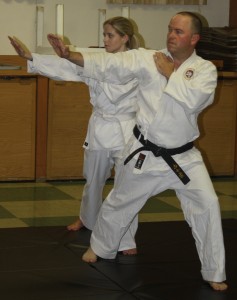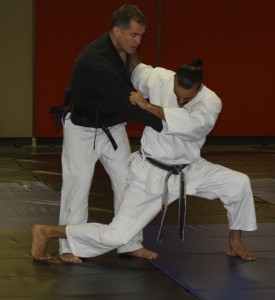The Kokondo Karate system is very kata-heavy. We have a large number of them as compared to most systems. We practice them a lot as compared to others. The reasons we do vs. the reasons they don’t are many and varied. Some styles will omit them entirely or use them for “reference”. Some will say they’re good for warmups but little else. Some stress them for tournament competition, adding a variety of acrobatic movements or other dramatics in order to “enhance” the form in order to impress the judges. Most all of those statements are followed by “but they’re useless for self-defense.”
I find this final phrase somewhat galling from my point of reference. To me, it smacks of someone that has not been fortunate enough to have been exposed to a knowledgeable instructor or, in many cases, someone that is just not interested or not ambitious enough to listen, pay attention and practice enough or properly.
As I have mentioned in earlier writings, our techniques are not a “one and done” matter. We do not (or, more accurately, should not) practice our techniques, be they kihon or kata, the same way we did a month, a year or ten years ago. While we have a limited number of ways the body will move and a limited number of techniques, the learning of how to use those movements and apply those techniques are virtually unlimited. We do not “return” to a particular kata as if in a circle. It should be thought of more as being on a spiral staircase. We are coming back to the same spot at a higher level than before. We should be able to execute the technique better but in addition we should have a better knowledge of what we are doing with it and in what context.
We begin learning our kata by having our movements dictated to us. “Move this direction in this stance and do this with your hands.” That process is repeated over and over until the requisite number of directions and steps in the form have been completed.
Do we “know” the kata at that point? Absolutely not! And this, unfortunately, is the fatal mistake some make. They get used to going this way and that, flinging their arms here and there, without any idea of what they are supposed to be doing. They have not stepped on to that spiral staircase and instead will forever wander around in circles.
This is where the presence and input of an experienced instructor is critical. It is also where the open mind and the willingness to learn of the student is equally, if not more, critical. Once the “walking” version of the kata has been learned, there must be extensive examination of the movements to learn the myriad possibilities of those movements. There needs to be a transmission of knowledge as to how to apply one set of movements to different attacks from different directions and angles. The concept that a movement can be one thing in one instance and something altogether different in another (block/strike vs. takedown/throw) needs to be stressed. Learning that the bunkai can be using movements 1-2-3 here, 2-3-4 there and 3-4-1 in another place, and that each instance requires a different speed and cadence must be understood. The kata has to evolve from a series of Fred Astaire dance steps (yeah, most of you don’t know who I’m talking about. Google it.) to a living, breathing battle against multiple adversaries.
There’s really no logical reason why we should continue to practice kata with the same punctuated movement or staccato rhythm used in first learning the kata. If the movements of the kata are to have meaning, then you need to practice as if you are engaged in using them in actual defense situations.
Unfortunately, this is where many students fall off the path. To fully develop one’s sense of what the movements are doing – to fully understand the bunkai of a kata – requires relentless practice. More practice opens more windows. You will start to see bunkai not only in the obvious movements but also in the transitional and/or “setup” movements. You will see things being done with the retracting hand that augment what the other hand is doing, or possibly even being the actual defense movement and the “real” strike/block is the augment. A punch is a strike, a block is a throw, a transitional movement in a stance sets up an off-balancing technique. The combinations and possibilities are truly endless.
Sound hard? Yes it is! This takes immeasurable hours of practice over a great number of years. I was once in the presence Shihan Arel (the founder of our system) and heard him state that he was finally beginning to understand Taikyoku One – the very first form!!
Think about this for a second……. Our founder, with decades of practice, was beginning to understand the kata that we teach to our newest students. Keep that in mind when you’re on the fifteenth rep of the form you’re working on and feeling bored with it.
This kind of work, this kind of knowledge, cannot be spoonfed by your instructor. They can point you in the right direction. They can put you back on course if you start to wander off. They can correct your technique or stance. The bottom line, though, is that what you learn, how fast, how far and whether or not your technique is going to save your bacon if needed is purely up to you.
It boils down to two simple questions: 1) Are you practicing your kata in karate class – or – are you practicing your karate through your kata?
2) Are you only practicing your kata in class?
Answer those two questions truthfully and then ask yourself who is responsible if you don’t understand what you’re doing.
Then get back to work.


